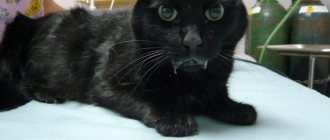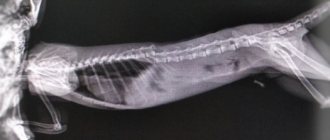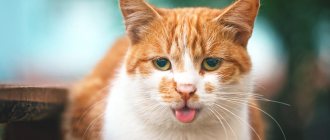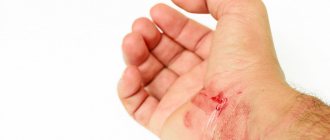08.04.2021
A hip fracture in a cat can occur as a result of a fall from a great height or other injuries. Regardless of the circumstances, it is necessary to immediately show the animal to a veterinarian, who will make the most complete diagnosis, determine the severity of the situation and prescribe treatment.
General information
Practicing veterinarians around the world estimate that femoral bone injuries account for about 25% of calls (of all fractures) for small animal owners. Especially often, young, unsterilized pets that are injured in the spring are brought to clinics. Motorists also don’t like the time when cats’ hormones are rampant: “romantics” of all colors and breeds regularly find themselves under the wheels of vehicles. So if your pet does not have a high breeding value, we advise you to sterilize it. This can save the animal from many troubles, including deadly ones.
“Femoral” varieties are divided into the same way as other types of fractures. They can occur in both young and old (more often) animals, and can be open or closed. Fractures of the femur are divided into simple and complicated (with the formation of fragments and/or damage to the round ligament).
It is not by chance that we draw attention to this: the therapeutic strategy directly depends on these factors, and therefore special attention should be paid to diagnosis. You also need to take into account that the recovery period after hip fractures is long and can last for a couple of months. So owners of recovering pets require remarkable patience and diligence.
Indications for use
Osteosynthesis is a complex, serious operation that is performed under anesthesia. But in most cases, after injuries to cats, the doctor chooses this particular method of treatment. It is especially often used for complicated fractures. There are also the following indications for the operation:
- open fractures with damage to soft tissues and blood vessels;
- the presence of multiple fragments;
- old injuries that have not healed for a long time or have not healed properly;
- intra-articular fractures.
Predisposing factors
As we have written more than once, the main cause of a hip fracture is various types of injuries. If you live in a city or in a private house, but near a highway, it is advisable to leave your cat locked up more often. But still, in veterinary practice, so-called atraumatic fractures are often encountered. The term means that the cat receives damage not due to mechanical stress, but due to the action of other pathological factors (internal environment):
- Poor quality food . In practice, fractures caused by this cause are vanishingly rare. Almost all foods used to feed cats contain normal amounts of calcium and phosphorus, so to achieve this result, the animal does not need to be fed at all.
- Kidney failure , since with this pathology there is a massive leaching of calcium and phosphorus from the bones.
- Endocrine disorder such as hyperparathyroidism.
- Inflammation of bone tissue (osteomyelitis).
- cancer (neoplasia).
Features of bone tissue of young cats
A hip fracture in a kitten is especially dangerous. Young bones have growth plates (fusis), on which osteocytes constantly and rapidly grow, subsequently undergoing mineralization. These areas are much weaker than other areas of the bones, and therefore more susceptible to mechanical injuries. Moreover, fractures of the fusis are extremely dangerous. The fact is that after such injuries, areas of the growth zones are damaged, as a result of which normal bone growth no longer occurs. The cat remains “bumpy”, with paws of different lengths.
So, the most typical damage to the femur in young animals:
- Fusis fracture in the immediate vicinity of the hip joint. The most unpleasant variety, since in the future the animal will almost inevitably have major problems with walking.
- Damage to the distal fusion (near the knee joint).
- Also, in young animals, the femur can break in the middle, which practically never happens in mature pets.
Features of bone tissue of old animals
The bones of adult animals have a more uniform density and strength, and therefore it is difficult to predict where exactly the fracture zone will be located. But the most common fracture is the femoral neck, as well as the area near the knee joint.
It must be taken into account that all cases of hip fracture must be considered individually, taking into account the general complexity and danger of such injuries to the health and even life of the pet (there are many large vessels near the bone). Both the age of the animal, the abilities of the surgeon, and the financial capabilities of the breeder are taken into account (not everyone can handle the installation of titanium implants).
In addition, during the postoperative period, it is necessary to strictly follow the recommendations of the veterinarian, since otherwise a variety of troubles are possible, including incompletely fused bones and the formation of false joints. Please note that caring for a cat in this case is a painstaking and responsible task.
Animal anatomy - femur fracture in a cat
In order for you to get a more detailed picture on this topic, we bring to your attention an analysis of the anatomical structure of the femur . Let's look at the structure of the entire musculoskeletal system in cats. Typically, there are two parts to the motor system:
1 forelimb belt. This part of the body has some distinctive features in its structure. Since, due to its origin, a cat is a fairly flexible and mobile animal, nature provides elastic fastening of the forelimbs. This is necessary for various movements. The cat anatomically lacks a collarbone. When walking and running, cats do not step on the surface with their entire foot. They walk on tiptoes. The location of the heel and knee allows you to move on your toes, obeying all the laws of physics. The front paws have five toes; 2 hind limb belt. If the belt of the forelimbs does not have a rigid attachment to the shoulder joint, here, on the contrary, the thigh is very powerfully attached to the sacrum. The hind legs are very strongly developed both bone and muscle, since when jumping the main load falls on the hips. And this presupposes the presence of a rigid bone frame. The hind limbs consist of the toes, heel, thigh and rump. The hind legs have lower mobility than the front legs.
As you can understand, with a hip fracture, a cat can lose a significant part of its mobility, which will not even allow it to move fully.
Diagnostics
Immediately after an injury, it is vitally important to take the animal to a veterinarian: fractures of the femur often damage large vessels, which leads to arterial collapse and death from blood loss. Additionally, the following is checked:
- X-rays of the pelvic and thoracic (!) cavities . Everything is clear with the pelvis, but why “see through” the chest? It's simple. Since hip fractures are a common consequence of vehicles hitting a cat, it doesn't hurt to make sure there are no other injuries.
- Conducting a comprehensive orthopedic examination . This is extremely important. In particular, to determine the presence/absence of damage to joints and ligaments. Both full palpation of the entire affected limb and a neurological examination are carried out. By the way, the future prognosis of recovery largely depends on the latter. If fragments of the femur catch large nerve cords, the animal may well remain disabled, despite complete and “high-quality” fusion of the fracture zone itself.
- Radiographs of the affected limb . Of course, this is one of the most important procedures. Only with the help of x-rays can one determine the “quality” of the fracture, the number and size of the fragments formed, and the presence or absence of other injuries. Based on the results of the radiographs, a decision is made on further treatment for the pet.
Note! No other diagnostic tests are required to make a definitive diagnosis.
What are the characteristics of different types of fractures?
Previously, we looked at the actions of cat owners and veterinarians in the event of a “paw fracture” - that is, a fracture of the long tubular bones of the limbs. In a cat, these are the following types of fractures with their symptoms and treatment: hip fractures - that is, the femur, as well as the neck and head of the femur, tibia fractures - the tibia and fibula, humerus fractures - the humerus and forearm fractures - the radius and ulna. . These types of fractures are encountered most often in the practice of a veterinary traumatologist. Let us now move on to the nuances characteristic of other types of fractures.
Treatment
Therapeutic approaches vary depending on the severity of the injuries and may include the following:
- Providing emergency care to relieve shock caused by blood loss, soft tissue injuries, etc. The faster the shock is eliminated, the better the future prognosis. It is necessary to immediately administer sedatives and solutions to bring the total blood volume in the body to normal levels. In addition, in severe cases, a blood or at least plasma transfusion is urgently required.
- Surgical treatment of the wound surface is mandatory , since otherwise it is quickly subject to contamination with pathogenic and conditionally pathogenic microflora. Crushed tissues are cut off to avoid their “spoilage” with the subsequent development of intoxication phenomena.
Note that almost all types of hip fractures are treated with surgery. Treatment without surgery is possible only in rare cases when the fracture area is completely clean, there are no fragments or gross displacements.
So, the main recommendations of experts are as follows:
- If the severity of the fracture is low (no soft tissue tears, no bleeding, etc.), a tight bandage, plaster, splints and other fixing devices are immediately applied, after which the pet must be taken to a veterinary clinic as quickly as possible.
- But, as we have already said, it is not possible to get away with it in not all cases, and therefore an operation is necessary, during which the ends of the broken bone and fragments are fixed . To do this, plates, bolts, pins and other “fixators” are attached (outside or directly to the bone). As a rule (especially in older animals), veterinarians resort to internal plates and pins that remain in the cat’s body for the rest of its life.
- Even in cases where the fracture appears to be “clean”, the application of plaster and splints on a “permanent” basis is highly discouraged. As practice shows, such methods of fixing these injuries are almost useless; they do not provide adequate strength, as a result of which false joints often develop.
- All examinations (even if a hip fracture is suspected) should be performed only after the animal has been given analgesic and sedative drugs. Otherwise, the animal may die from painful shock .
If your cat is even hit by a bicycle (not to mention a car), immediately take him to the veterinarian, even if outwardly it seems that everything is fine with the pet!
Tips for the owner of a recovering animal
Do not play with the cat, remove from the room all objects that he might try to jump on. Active movements during such a period are completely unacceptable!
If you see blood or exudate (especially purulent) on postoperative dressings or fixation devices, you should call your doctor immediately.
Pets undergoing surgery should be taken to the veterinarian at least once a week, as during this period it is very important to constantly check how the wound is healing. It is believed that it is advisable to take an x-ray at least once every two weeks : the process of callus formation will be clearly visible in the image. Full recovery from surgery may take up to three months.
Recovery
Healing of fractures in cats occurs in 3-8 weeks. The speed of recovery depends on the severity of the injury, the osteosynthesis technique used, and the owner’s compliance with rehabilitation recommendations. After surgery, you need to visit the doctor several times:
- the first time after 2-3 days to assess the condition of the stitches and the cat’s well-being;
- if necessary, the doctor schedules a visit to remove stitches;
- a month later, a routine examination with an x-ray is carried out, which will help assess the success of healing;
- After complete fusion of the bones, if necessary, a repeat operation is prescribed to remove the fixing elements.
External spokes are always removed; the remaining fasteners may not be removed. Intraosseous pins are left. If the plates or other structures do not interfere with movement or cause discomfort, they can remain. The decision is made by the doctor after examining the animal. A repeat operation is performed to remove the fixing elements. It goes away faster, and the cat recovers easier after it.
Typically, recovery after osteosynthesis is easy and without problems. But for this you must follow the doctor’s recommendations.
- For the first few days, limit the animal's mobility. To do this, it is best to place it in a spacious cage. This allows you to avoid repeated injury and displacement of the fixing elements. To prevent the cat from licking the seams and chewing the structures, a special collar is put on her.
- Be sure to give your pet medications prescribed by your doctor. Painkillers and anti-inflammatory drugs are usually given for the first few days. In most cases, the doctor prescribes a course of antibiotics, which helps to avoid complications. Sometimes vitamins, restorative drugs, and medications that stimulate healing are also used.
- It is necessary to treat the seams with products prescribed by the doctor. You need to keep your cat clean so that the wound does not get infected.
- After 3-5 days, the cat may begin to lean on the injured limb. It is even recommended to stimulate her to do this in order to avoid muscle atrophy. Moderate loads are necessary to speed up healing.
Our clinic provides osteosynthesis for cats for any fractures. High-quality materials and modern techniques are used to reduce discomfort for the animal. The operation is carried out according to all the rules, and recommendations are given to the owner on how to care for the animal. This ensures a quick recovery without complications and restoration of the cat's mobility.










